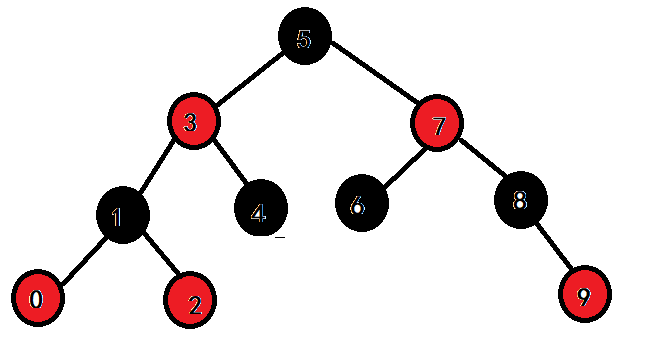首先什么是二叉搜索树?
二叉搜索树又称为二叉排序树,它是一个空树或者具有以下性质:
1)若它的左子树不空,则左子树上的所有节点的值都小于根节点的值
2)
若它的右子树不空,则右子树上的所有节点的值都大于根节点的值
3)它的左右子树也分别为二叉搜索树
由二叉树的定义可以看出它是递归定义的,下面是一些二叉树的基本操作的递归实现:
typedef int DataType;
typedef struct BSTreeNode
{
struct BSTreeNode *pLeft;
struct BSTreeNode *pRight;
DataType _data;
}BSTreeNode;
//插入结点递归
void InsertBSTree(BSTreeNode **pRoot, DataType data)
{
assert(pRoot);
if (NULL == *pRoot)
*pRoot = BuyBSTNode(data);
else
{
//若根节点的值大于插入结点的值,就插入到左子树中
if ((*pRoot)->_data > data)
InsertBSTree(&(*pRoot)->pLeft, data);
//若根节点的值小于插入结点的值,就插入到右子树中
else if ((*pRoot)->_data < data)
InsertBSTree(&(*pRoot)->pRight, data);
else
return;
}
}
//删除结点---递归
void DeleteBSTree(BSTreeNode **pRoot, DataType data)
{
assert(pRoot);
if (NULL == *pRoot)
return;
//在左子树中删除
if ((*pRoot)->_data > data)
DeleteBSTree(&(*pRoot)->pLeft, data);
//在右子树中删除
else if ((*pRoot)->_data < data)
DeleteBSTree(&(*pRoot)->pRight, data);
//删除根节点
else
{
BSTreeNode *pDel = *pRoot;
//待删除结点有右子树或者为叶子结点
if (NULL == pDel->pLeft)
{
*pRoot = pDel->pRight;
free(pDel);
}
//待删除结点只有左子树
else if (NULL == pDel->pRight)
{
*pRoot = pDel->pLeft;
free(pDel);
}
//待删除结点左右子树都有
else
{
//找右子树中最左边的结点
pDel = (*pRoot)->pRight;
while (pDel->pLeft)
pDel = pDel->pLeft;
(*pRoot)->_data = pDel->_data;
DeleteBSTree(&(*pRoot)->pRight, pDel->_data);
}
}
}
//找树中是否有此结点
//递归
int FindBSTNode(BSTreeNode *pRoot, DataType data)
{
if (NULL == pRoot)
return 0;
if (pRoot->_data > data)
return FindBSTNode(pRoot->pLeft, data);
else if (pRoot->_data < data)
return FindBSTNode(pRoot->pRight, data);
else
return 1;
}
//销毁二叉搜索树
void DestroyBSTree(BSTreeNode **pRoot)
{
assert(pRoot);
if (*pRoot)
{
DestroyBSTree(&(*pRoot)->pLeft);
DestroyBSTree(&(*pRoot)->pRight);
free(*pRoot);
*pRoot = NULL;
}
}
对于删除结点,插入结点和在二叉搜索树中查找结点也有非递归的实现,如下:
//插入结点
//非递归
void InsertBSTreeNor(BSTreeNode **pRoot, DataType data)
{
assert(pRoot);
if (NULL == *pRoot)
*pRoot = BuyBSTNode(data);
//找插入结点的位置
BSTreeNode* pCur = *pRoot;
BSTreeNode* pParent=NULL;
while (pCur)
{
if (pCur->_data > data)
{
pParent = pCur;
pCur = pCur->pLeft;
}
else if (pCur->_data < data)
{
pParent = pCur;
pCur = pCur->pRight;
}
else
return;
}
//进行插入
pCur = BuyBSTNode(data);
if (pParent->_data > pCur->_data)
pParent->pLeft = pCur;
else
pParent->pRight = pCur;
}
//删除结点
//非递归
void DeleteBSTreeNor(BSTreeNode **pRoot, DataType data)
{
assert(pRoot);
//1.查找删除结点的位置
BSTreeNode *pCur = *pRoot;
BSTreeNode *pParent = *pRoot;
while (pCur)
{
if (pCur->_data > data)
{
pParent = pCur;
pCur = pCur->pLeft;
}
else if (pCur->_data < data)
{
pParent = pCur;
pCur = pCur->pRight;
}
else
break;
}
//待删除结点不在树中
if (pCur == NULL)
return;
//待删除结点在树中
//2.删除
//(1)待删除结点只有右孩子或者为叶子结点
if (pCur->pLeft == NULL)
{
//1)待删除结点为根
if (pCur == *pRoot)
*pRoot = pCur->pRight;
//2)待删除结点不是根
else
{
//若待删除的结点为左子树,则父结点的左指针指向待删除结点的孩子
if (pCur == pParent->pLeft)
pParent->pLeft = pCur->pRight;
else
pParent->pRight = pCur->pRight;
}
}
//(2)待删除结点只有左孩子
else if (pCur->pRight == NULL)
{
//1)待删除结点为根
if (pCur == *pRoot)
*pRoot = pCur->pLeft;
//2)待删除结点不是根
else
{
//若待删除的结点为左子树,则父结点的左指针指向待删除结点的孩子
if (pCur == pParent->pLeft)
pParent->pLeft = pCur->pLeft;
else
pParent->pRight = pCur->pLeft;
}
}
//(3)待删除结点左右孩子都有
else
{
//1)找待删除结点左子树的最右边结点或者右子树的最左边结点
BSTreeNode *pDel = pCur->pRight;
pParent = pCur;//若pCur没有左子树,pParent就不会更新
while (pDel->pLeft)
{
pParent = pDel;
pDel = pDel->pLeft;
}
//2)将pDel的值赋给pCur
pCur->_data = pDel->_data;
//3)删除pDel,此时pDel只有右子树或者为叶子结点
if (pDel == pParent->pLeft)
pParent->pLeft = pDel->pRight;
else
pParent->pRight = pDel->pRight;
pCur = pDel;
}
free(pCur);
pCur = NULL;
}
//找树中是否有此结点
//非递归
int FindBSTNodeNor(BSTreeNode *pRoot, DataType data)
{
BSTreeNode *pCur = pRoot;
while (pCur)
{
if (pCur->_data == data)
return 1;
else if (pCur->_data > data)
pCur = pCur->pLeft;
else
pCur = pCur->pRight;
}
return 0;
}
二叉搜索树的性能:
最优情况下,二叉搜索树为完全二叉树,其平均比较次数为:logN
最差情况下,二叉搜索树退化为单支数,其平均比较次数为:N/2
因此有AVL树和红黑树:
AVL树:一棵AVL树或者是空树,或者是具有以下性质的二叉搜索树:1)它的左右子树都是AVL树 2)左右子树高度之差(平衡因子)的绝对值不超过1(-1、1、0)
AVL树的平均搜索时间为O(logN),避免了二叉搜索树最差的情况。
红黑树:比AVL树性能高,红黑树最长路径不超过最短路径的两倍
红黑树性质:1)每个节点不是红色就是黑色
2)根结点是黑色
3)不可能有连在一起的红色结点
4)对于每个结点,从该结点到其所有后代叶节点的简单路径上,均包含相同数目的黑色结点
5)每个叶子结点都是黑色的(此处的叶子结点指的是空结点)
如图:
